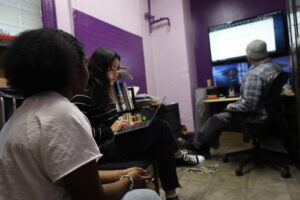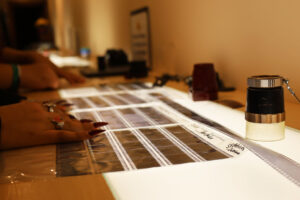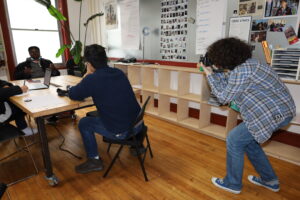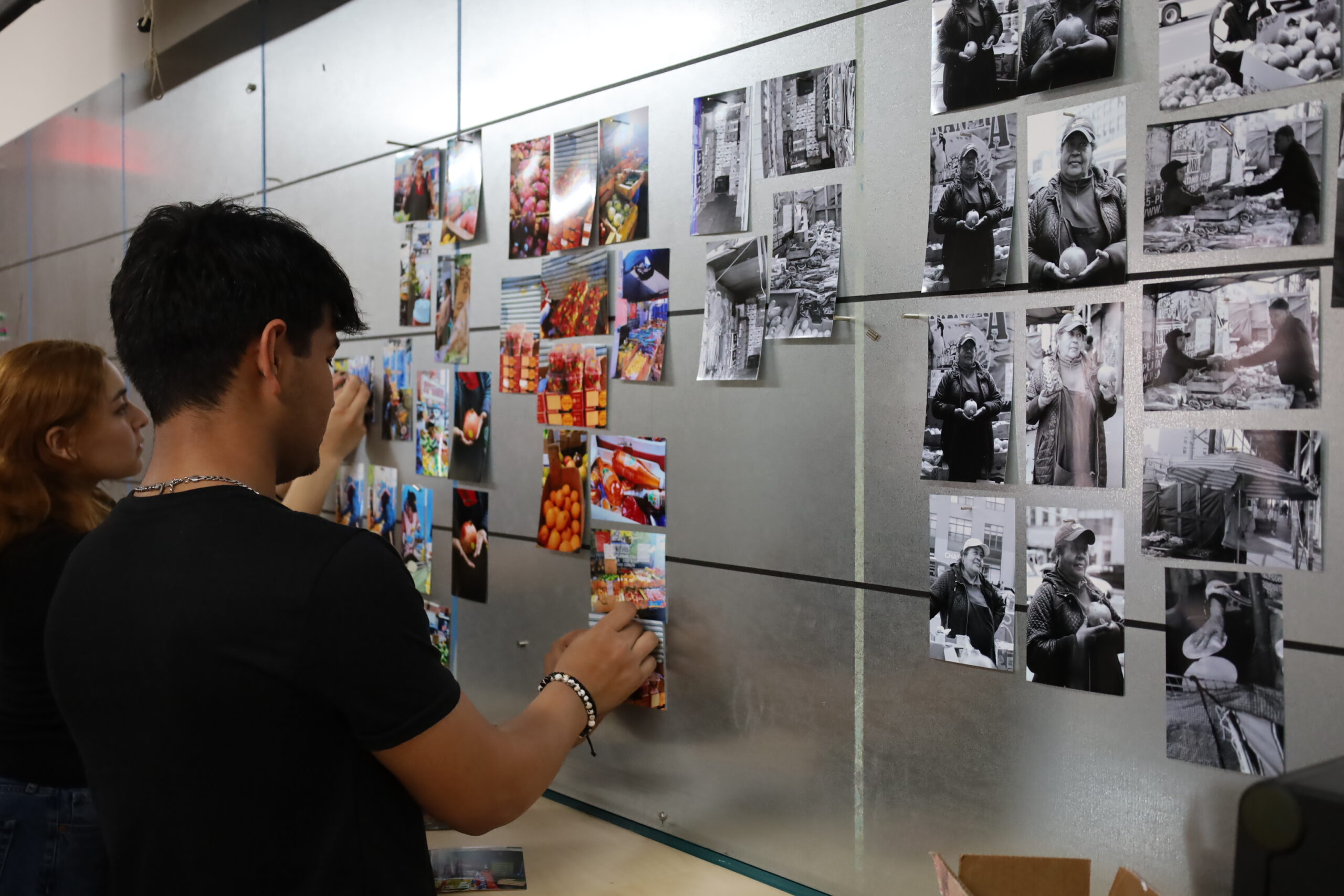Para leer una version en español, vaya aquí.
A map showing how close to South Bronx schools a horde of new cannabis retail stores have sprung up is tacked up to a wall in the Bronx Documentary Center annex. It was created by a group of Bronx high school students to guide their reporting for a new issue of “BDC Focus,” a newspaper telling the stories of the people, workers and life in neighboring communities.
For years, the Melrose-based Documentary Center has offered twice weekly photo courses for Bronx middle school students and two for high school students in its Bronx Junior Photo League program, taught through the lens of community justice. In the past year, that instruction has expanded to include reporting, writing and critical thinking in one of its two high school sections.
“This is our inaugural class,” said Ricardo Partida, manager of the youth education program for the past year and creator of “BDC Focus.”
The first issue of “BDC Focus,” which published in December 2022, was produced specifically by the new journalism class. Both high school sections are collaborating on the second issue.
Partida came up with the idea and Pamela Rozon is its inspiration. An alumna of the photo program and now educational program assistant and co-editor – “[Rozon] was told by professors that it would be hard to break into journalism and she became discouraged,” said Partida. And that’s how “Focus” was born – as a way for Rozon and people like her to practice the craft and get samples of their work into the hands of prospective employers.
The first issue of “Focus” made local headline news when students noticed floodlights burning 24/7 at several NYCHA buildings in Melrose. After documenting the lights for two months, several times a week, students concluded that NYCHA was violating its own guidelines and costing taxpayers $82,000 in unnecessary expenses. NYCHA – and News 12 in the Bronx – took notice, but the lights are still on at two of the three buildings.
Other “BDC Focus” stories looked at the personal lives of street vendors, and one focused on the power and perseverance of a single mom. Students are also reporting on the Garifuna community in the Bronx. All work is entrenched in their communities with an eye for solutions.

Class sessions
On a recent Monday, students were broken up into researchers, writers and photo editors. Writers went through edits with Mike Kamber, the Documentary Center’s founder and New York Times veteran photojournalist. Photo editors worked with teachers on a storyboard, using photos the students took and developed themselves. Others conducted an interview with a Garifuna street vendor and took notes as Elisa Luna Cameron, 17, snapped photos. All sessions were supervised by professionals who provided insight and feedback.
In the approximately 39-week program, students in the journalism section are taught interviewing skills and the value of listening. They are warned of hyperbolic language and are encouraged to be as accurate and specific as possible. They get deeply involved with their community and the people around them. All students learn the basics of framing an image, how to use an analog camera, how to develop their own film in the Center’s sophisticated darkroom, and to dive deep into the neighborhood that surrounds them and the stories it has to tell.
“Journalism is about having endless curiosity and telling the right story,” said Partida.
All student courses, which meet for two hours after school twice a week, are free of charge. At the end, each student’s photo projects are featured in the gallery of the Bronx Documentary Center on Courtlandt Avenue, around the corner from the annex, where instruction takes place.

Students
Students expressed an interest in photography and/or journalism as a career, and their passion was palpable.
Brandon Carrillo Leon, 15, reported, “I’ve been here 11 days straight.” In addition to working on photo assignments, he also enjoys helping out with odd jobs like building a display case for cameras that are sold at the center. In the April 6 class, he was working as photo editor and going through film negatives to scan.
Joining him at the photo light table was Alexa Pacheco, 16, who travels home to Throgs Neck from the South Bronx after the class is over. Her commute is over an hour, but she still dedicates about three days a week to the program because, “that’s how much I love it,” she said.
Pacheco’s interest in photography started when she took a photo class at the Bronx River Art Center when she was in sixth grade. She wanted to do more with photography. Wanting to foster her interests, Pacheco’s mother researched programs in the Bronx and landed on the Documentary Center. Pacheco has now been part of the program for four years.
Maya Sanchez, 15, was walking from school at Hostos Lincoln Academy of Science when she stumbled upon the Documentary Center. “I saw a flier and I was like, ‘Might as well sign up, I have nothing else to do for the weeks,’” she said. Sanchez has now been in the education program for two years.

The Mission
The thoughtful reporting in the new student-powered paper is a logical extension of the Documentary Center’s mission, defined on its website as: “The BDC uses community-based documentary practice and education to explore vital issues, stimulate critical thought, and drive social change.”
But the physical paper – as well as the experience developing photos from film – also provides youngsters with an important tactile experience.
“A lot of kids have literally never done anything with their hands,” said Kamber, who spoke about growing up building tree forts and fixing old cars. “Once [the students] start working with their hands, they love it and it’s so empowering for them.”
Kamber encourages everyone to stop by the Documentary Center and participate in workshops, tours, and classes. There are adult and senior photo leagues, film classes and much more. His approach, as well as the other instructors, is laid-back, but thorough. There is a clear dedication to truth and accuracy.
Years ago, when he looked at photography programs in New York City, many of them came with a price tag of several thousand dollars. “‘There’s gotta be a place to do this for free,” he thought. So he created one.
He added, “Photography changed my life and we want to spread that love.”

